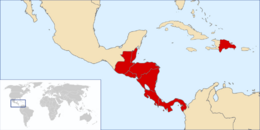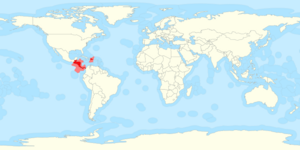Central American Integration System facts for kids
Quick facts for kids
Central American Integration System
|
|
|---|---|
|
Anthem: La Granadera
The Grenadier |
|

States in the Central American Integration System.
|
|
| Administrative center | |
| Official languages | Spanish |
| Type | Regional organization |
| Membership | 8 states 11 regional observers 21 extraregional observers |
| Leaders | |
|
• President pro tempore
|
Johnny Briceño |
|
• General Secretary
|
Werner Isaac Vargas Torres |
| Legislature | Central American Parliament |
| Establishment | |
| 20 December 1907 | |
|
• ODECA
|
14 October 1951 |
|
• CACM
|
13 December 1960 |
|
• SICA
|
13 December 1991 |
| Area | |
|
• Total
|
572,510 km2 (221,050 sq mi) |
| Population | |
|
• 2009 estimate
|
51,152,936 |
|
• Density
|
89.34/km2 (231.4/sq mi) |
| GDP (PPP) | 2010 estimate |
|
• Total
|
$506.258 billion |
|
• Per capita
|
$9,898.17 |
| GDP (nominal) | 2010 estimate |
|
• Total
|
$266.213 billion |
|
• Per capita
|
$5,205.45 |
|
Website
sica.int |
|
The Central American Integration System (Spanish: Sistema de la Integración Centroamericana, or SICA) is an important group of countries in Central America. It helps these countries work together on economic and political goals. SICA officially started on February 1, 1993.
Its main goals are to encourage peace, democracy, and economic development in the region. The main office for SICA is in El Salvador.
When SICA began in 1991, its first members were Guatemala, El Salvador, Honduras, Nicaragua, Costa Rica, and Panama. Later, Belize joined in 1998. The Dominican Republic became a full member in 2013.
Other countries like Mexico, Chile, and Brazil are "regional observers." This means they watch and learn from SICA's meetings. Countries like Spain, Germany, and Japan are "extra-regional observers." SICA also works with the United Nations.
Four countries (Guatemala, El Salvador, Honduras, and Nicaragua) have a special group called the CA-4. They have common borders and use the same type of passport. This makes travel easier between them. Other SICA members like Belize, Costa Rica, Panama, and the Dominican Republic also work closely with the CA-4 for economic reasons.
Contents
Where is SICA Located?
SICA's main office, called its administrative center, is in San Salvador, El Salvador.
A Brief History of Central American Unity
Early Attempts at Cooperation (1907)
Central American countries have a long history of trying to work together. In 1907, five countries (Costa Rica, El Salvador, Guatemala, Honduras, and Nicaragua) met in Washington, D.C. They wanted to create a way to solve problems peacefully.
This meeting led to the creation of the Central American Court of Justice. This court had five judges, one from each country. It worked for about ten years, helping with disputes. However, it eventually closed because its rules were not strong enough. Also, the judges were not always fully independent from their governments.
The Organization of Central American States (1951)
After World War II, countries in Central America wanted to try again to unite. In 1951, Costa Rica, El Salvador, Guatemala, Honduras, and Nicaragua formed the Organization of Central American States (ODECA). Their goal was to help the region cooperate and become more united.
In 1952, they created a new Central American Court of Justice. This new court did not have a time limit. ODECA helped set up other important groups, like the Central American Common Market (CACM) and the Central American Bank for Economic Integration (BCIE). These groups aimed to improve trade and the economy.
However, progress stopped for a while after a conflict between Honduras and El Salvador in 1969. ODECA was put on hold in 1973.
SICA: A New Start for Integration (1991)
In 1991, the idea of Central American unity got a fresh start with the creation of SICA. SICA provided a clear legal way to solve problems between member countries. The United Nations General Assembly supported SICA in 1993.
SICA now includes seven Central American nations and the Dominican Republic. It has several important groups, such as the Central American Parliament and the Central American Bank for Economic Integration. These groups work to improve trade and cooperation. For example, the Central American Common Market has removed taxes on most products traded between member countries. This helps boost trade in the region.

Who are SICA's Members and Observers?
Member States
These are the countries that are full members of SICA:
| Flag | State | Capital | Largest City | Accession | Population (2023) |
Area | Population density | HDI (2019) | |
|---|---|---|---|---|---|---|---|---|---|
| Belize | Belmopan | Belize City | 1998 | 383,071 | 22,966 km2 (8,867 sq mi) |
16/km2 (41/sq mi) |
0.716 | ||
| Costa Rica | San José | Founder | 4,999,441 | 51,100 km2 (19,700 sq mi) |
95/km2 (250/sq mi) |
0.810 | |||
| Dominican Republic | Santo Domingo | 2013 | 10,627,141 | 48,671 km2 (18,792 sq mi) |
219/km2 (570/sq mi) |
0.756 | |||
| El Salvador | San Salvador | Founder | 6,420,746 | 21,041 km2 (8,124 sq mi) |
302/km2 (780/sq mi) |
0.673 | |||
| Guatemala | Guatemala City | Founder | 17,247,849 | 108,889 km2 (42,042 sq mi) |
152/km2 (390/sq mi) |
0.663 | |||
| Honduras | Tegucigalpa | Founder | 9,587,522 | 112,090 km2 (43,280 sq mi) |
81/km2 (210/sq mi) |
0.634 | |||
| Nicaragua | Managua | Founder | 6,465,501 | 130,370 km2 (50,340 sq mi) |
47/km2 (120/sq mi) |
0.660 | |||
| Panama | Panama City | Founder | 4,176,869 | 75,420 km2 (29,120 sq mi) |
53/km2 (140/sq mi) |
0.815 | |||
| 8 total | 58,096,944 | 570,547 km2 (220,289 sq mi) |
102/km2 (260/sq mi) |
0.716 | |||||
Regional Observers
These countries are from the same region and observe SICA's work:
Extra-Regional Observers
These countries are from other parts of the world and observe SICA's work:
How SICA Helps the Economy
SICA works to make the economies of its member countries stronger. The Central American Bank for Economic Integration helps with this. It supports projects that lead to more jobs and better living conditions.
The region is working to increase trade between its members. They have removed many taxes on products traded within SICA. This makes it easier and cheaper for businesses to buy and sell goods across borders.
Working Together on Policies
SICA also helps countries work together on common rules and policies. For example, there are ideas to make air travel between member countries feel like domestic travel. This would make it easier for people to visit different countries in the region.
Another idea is to get rid of roaming fees for phone calls. This would mean you wouldn't pay extra to use your phone when traveling between SICA countries. They are also looking into creating a special prison for serious regional and international crimes.
Important SICA Organizations

SICA has several important groups that help it achieve its goals:
- Central American Parliament (PARLACEN): This is like a regional parliament. It has elected representatives from most SICA countries. They discuss and propose laws that can help the whole region.
- Central American Court of Justice (CCJ): This court helps solve disagreements between member countries. It also gives advice to the highest courts in the region. Its main goal is to promote peace and unity.
- Central American Bank for Economic Integration (BCIE): This bank provides money for projects that help the region's economy grow.
- Central American Common Market (CACM): This group works to make trade easier and more open between member countries.
- Central American Armed Forces Conference (CFAC): This group helps the armed forces of member countries work together.
- President's Summit: The leaders of the SICA countries meet regularly to make important decisions.
See also
 In Spanish: Sistema de la Integración Centroamericana para niños
In Spanish: Sistema de la Integración Centroamericana para niños
- Latin American Integration Association
- Central America-4 Border Control Agreement
- Central America-4 passport
- Mercosur



